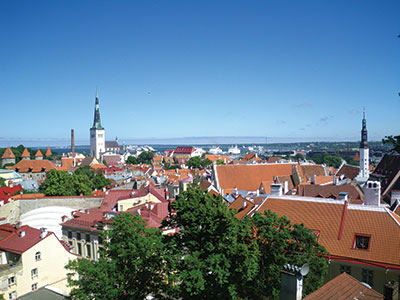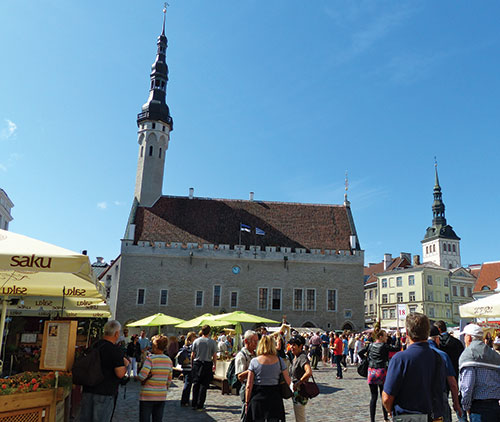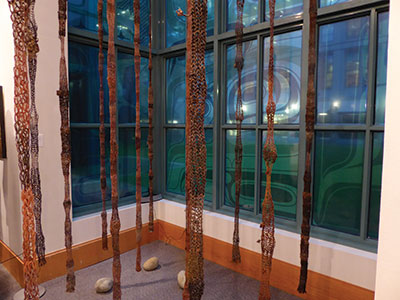By Ursula Maxwell-Lewis
Coach trips: Time limited travel testers
Hopefully, the Canadian dollar slump won’t deep-six your travel plans. Although Britain can be costly, a coach trip might be worth investigating. I’ve only been on one – a very quick whip through England, Scotland, and Wales. However, the satisfying result was that I earned quick glimpses of places I might have missed, or not have had time for when wandering solo. Here are a couple of them.
DURHAM, England: Drama generally surrounds sagas concerning saints – and many sinners, too now that I think about it. However, it was St. Cuthbert’s journey to his final resting place on the banks of the River Wear in north east England which fired my imagination during a 7-day Insight Vacations coach trip. After all, being greeted by a sculpture of six monks solemnly bearing a casket has to be an attention-getter for any tourist clambering off a bus and up to a hilltop city.
In the late 9th century Benedictine monks fled their base in Lindisfarne, then the north eastern Kingdom of Northumbria, to escape Viking invaders. Taking with them their most precious possession, the coffin containing the remains of St. Cuthbert and the Lindisfarne Gospels, they roamed north to Whithorn in Scotland, south across the Pennines to Crayke in Yorkshire, and finally, in 883, they rested the casket at the hilly outcropping of Chester le Street. When preparing to continue their journey they were surprised to find that the casket refused to move. Clearly a sign that they had arrived at their destination, they built a wooden church around the coffin to house the body of their saint. That ancient church no longer exists, but Durham Cathedral, now a UNESCO World Heritage Site, towers nearby as a testament to St. Cuthbert (c.634-687), medieval monk, bishop and hermit. His feast day is March 20. Despite Henry VIII’s emissaries’ vandalism around 1540, grave relics were discovered and preserved.
Typical of it time, Durham’s history has been turbulent and convoluted. For example, following the Battle of Dunbar in 1650 Cromwell closed Durham Cathedral in order to incarcerate 3,000 Scottish soldiers. In 2013, when nearby Durham University’s Palace Green Library was being built, two mass graves were unearthed. Research concluded that the graves were those of the soldiers.
Open Treasure, a £10 development investment, opens this year. Visitors can explore the Monk’s Dormitory (the only one of its kind in England), the Great Kitchen, a wealth of exhibits along the way, plus many previously hidden spaces. A glass-sided elevator has been installed next to the monk’s staircase to make access easier for less agile visitors.
Durham is a university, and market town attracting tourists, pilgrims and academics. Its dignity, charm, and aura of things-yet-to-be-discovered are undenyable. I would like to have spent longer exploring the area. Woodland and river history walks are available. Pay at the cathedral door, but book ahead online at http://www.durhamcathedral.co.uk. This site also includes an excellent video enhanced by Gregorian chants to get you in the appropriate mood. Entrance to the cathedral is by donation, preferably a large one suggests the very practical literature at the door.
TINTERN ABBEY, WALES: A place of legends, and – for me luck. I’d always wanted to visit Tintern. Some forgotten reason inspired our excellent guide and driver to alter the southern part of our itinerary to include a couple of hours at this haunting abbey. I was delighted!
Tintern (Abaty Tyndyrn in Welsh) was a Cistercian Abbey founded in 1131 on the Rive Wye in Monmouthsire by Walter de Clare, Lord of Chepstow. It’s commanding – now roofless – church was constructed between 1269 and 1301. Perhaps this adds to its majesty, but it must have been stunning in its day.
When the Black Death plagued the country in 1348, attracting lay brothers must have been tough. Endless economic and social impacts altered the country. It is suspected it impacted the Tintern religious community, too.
Tintern Abbey became another victim of Henry VIII’s Dissolution of Monasteries on September 3, 1536 when 35 monastic servants and 12 choir monks were evicted from their sanctuary.
Although Tintern fell into ruin after the Dissolution in the 16th century, it remains a romantic, picturesque landmark. It has evolved into a tribute to contemplation and peace. Poets, writers, artists and photographers constantly attempt to capture what it conveys to them. Personally, on a sunny summer day I’d take a picnic and spend time photographing it while exploring this pastoral Welsh/English (Gloucestershire) border area. Being over-imaginative,Tintern whispered to me of untold tales, legends, and a long-vanished social structure. If you enjoy architecture, I have no hesitation in recommending this gracious, classic ruin.
Ursula Maxwell-Lewis is a British Columbia-based journalist and photographer
 By Chris Millikan
By Chris Millikan Market Square bustles. We notice the still operating 1422 pharmacy, said to be birthplace of marzipan. Years later, the world’s first decorated Christmas stood nearby. Still dominating the square, the towering 15th century town hall has provided space for a courthouse, warehouse, theatre…and now a museum.
Market Square bustles. We notice the still operating 1422 pharmacy, said to be birthplace of marzipan. Years later, the world’s first decorated Christmas stood nearby. Still dominating the square, the towering 15th century town hall has provided space for a courthouse, warehouse, theatre…and now a museum. Gwaii Haanas is a Haida Heritage Site, A National Park Reserve and Marine Conservation Area. Gwaii Haanas has 5000 km of rainforests, lakes and rivers and a great variety of birds.
Gwaii Haanas is a Haida Heritage Site, A National Park Reserve and Marine Conservation Area. Gwaii Haanas has 5000 km of rainforests, lakes and rivers and a great variety of birds. Victoria Moody, a weaver from Skidegate created the Transition Robe 2000 which features both wool and red cedar. The red cedar bark was collected from 6 Haida totem poles that were raised for the Haida Heritage Centre at Kay Linagaay.
Victoria Moody, a weaver from Skidegate created the Transition Robe 2000 which features both wool and red cedar. The red cedar bark was collected from 6 Haida totem poles that were raised for the Haida Heritage Centre at Kay Linagaay. This exhibit provided a lovely interlude on a rainy Vancouver afternoon.
This exhibit provided a lovely interlude on a rainy Vancouver afternoon. By Rick Millikan
By Rick Millikan


